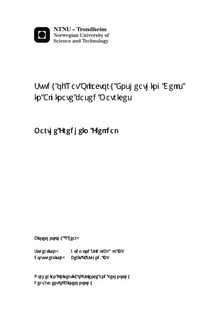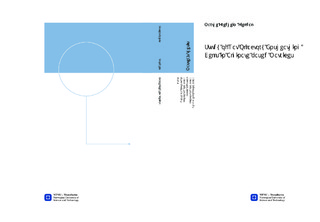| dc.description.abstract | Alginate hydrogel made from alginate and crosslinking divalent ions is a natural biomaterial that is biocompatible, has low toxicity, is relatively cheap and has mild gelation chemistry. It is a porous material that allows diffusion of small molecules. Alginate hydrogel is a polymeric network that contains 95-99% water and it does in many ways resemble the natural extracellular matrix (ECM) that surrounds cells in the body. It is also hydrophilic, which reduces friction in body fluids and minimizes protein adsorption and it is easily stored and sterilized.Alginate is produced by both algae and bacteria, and it is initially synthesized as mannuronan (M) with 100% M-residues. Guluronic acid residues (G) are introduced in a post-polymerization step by enzymes called mannuronan C-5 epimerases that catalyze conversion of M into G without breaking the glycosidic bond. Seven different mannuronan C-5 epimerases have been sequenced, cloned and produced recombinantly, and these enzymes introduce MG-blocks, G- blocks or both in the alginate chains. With the use of these mannuronan C-5 epimerases it is now possible to engineer alginate with desired and known structure. It is also possible to covalently modify alginates with coupling of cell specific adhesion molecules to the carboxylic group in the monomers. An example is the RGD peptide (arginine-glycine-aspartic acid) that is commonly found in collagen and fibronectin in the ECM. The RGD peptide is the smallest sequence that integrin receptors can recognize and bind to.Central nervous system (CNS) damage is still one of the major causes of both death and disability, despite intense research efforts to achieve neurogenesis and restore functional synaptic connection of CNS neurons. None of he current therapy strategies promote regeneration or regrowth of neural cells or axons. In vitro and in vivo studies has shown that CNS axons can regenerate when located in a permissive environment and it is known that on-going neurogenesis occurs in certain areas of the adult brain, such as the olfactory bulb. Olfactory ensheathing cells (OECs) are found in the olfactory mucosa and olfactory bulb and secrete neurotrophins, provide necessary ECM molecules and substrates for axon elongation and myelination. They do not activate and induce inhibitory molecules or hypertrophy in astrocytes, and are therefore believed to be a promising candidate for cell-mediated repair of the CNS.The major aims of this study was to investigate whether encapsulation of OECs in different types of alginate matrices would improve cell viability over time and induce change of cell morphology, as a future goal is to transplant OECs into the CNS. Viability of OECs up to 14 days in 1.8% UP-LVG capsules have been reported by Kristin Karstensen (Karstensen, 2010), and similar results were achieved in an experiment in this project. Indications of cell concentration dependency on viability were observed in this experiment, with higher viability in capsules with low cell concentration (1.5 mil cells/mL alginate, 3.0 and 5.0 mil/mL). It was decided to conduct an encapsulation of high and low OEC concentration (4.0 mil/mL and 1.0 mil/mL) in 1.0% UP-LVG Ca2+/Ba2+ alginate, with the aim of examining whether reduced alginate concentration would improve cell viability. The results were promising, with a live cell percentage of 50% in the low cell concentration batch after 51 days. The high cell concentration batch was discarded after 22 days with estimated 30% live cells. This result strengthened the hypothesis that lower cell concentration enhanced cell viability, and confirmed that lower alginate concentration improved cell viability notably. These indications were supported by the results of a second encapsulation with similar settings. High and low concentrations (1.5 mil/mL and 5.0 mil/mL) of OECs were encapsulated in 1.0% epimerized Ca2+ alginate with and without 0.2 % RGD peptide graft. The experiment did not show an effect of the RGD peptide on cell viability or morphology. The viability of the cells was extended with one week and viable cells could be observed for 22 days, but in this experiment increased viability as a result of lower cell concentration was less pronounced. This experiment was therefore inconclusive in terms of improved viability connected to cell concentration, but indicated that a lower alginate concentration had a beneficial impact on cell viability. Star shaped channels were observed inside all capsules in this experiment, and a large fraction of dead cells were found to be located inside these channels. This experiment was later repeated with another source of epimerized alginate grafted with ≈ 0.4% RGD peptide with comparable results in terms of cell viability and morphology.Two encapsulations of low cell concentration in 1.0% UP-LVG Ca2+/Ba2+ alginate mixed with three different concentrations of gelatin (0.5%, 1.0% and 2.0%) were carried out, with the aim of observing capsule stability and cell viability. In first experiment the capsule stability appeared to be inversely proportional with gelatin concentration. This was not confirmed when the experiment was repeated, as the batch with the middle gelatin concentration was perceived as most stable. The cell viability was overall high for both encapsulations. Finally, four batches of 1.5 mil/mL OECs were encapsulated in 0.9% UP-LVG Ca2+/Ba2+ alginate gel with one type of ECM molecule mixed with the alginate per batch to yield a concentration of 1.0 mg/mL. Sulphated MG alginate was mixed with 0.9% UP-LVG Ca2+/Ba2+ alginate to a final concentration of 1.0 mg/mL, and included in the experiment. The experiment was terminated at day 28, with varying cell viabilities in the different batches. Common for all was overall lower cell viability compared with the viability observed for cells with similar concentration encapsulated in pure 1.0% UP-LVG, but the capsules proved to be relatively stable. In conclusion, reducing the alginate concentration from 1.8% to 1.0% had notable positive effect on cell viability. High cell concentration in the alginate capsules also proved to have a negative impact on cell viability, but this effect was most evident in the UP-LVG alginate gels. The negative effect on cell viability related to high cell concentration was not as profound in the epimerized alginate gels.RGD peptide grafted onto alginate did not show any unambiguous effect on cell viability and no effect on cell morphology, regardless of 0.2 % peptide graft or ≈ 0.4% peptide graft. The gelatin-1.0% UP-LVG alginate mixes also failed to induce morphology change in the OECs, and neither did any of the ECM molecule-1.0% UP-LVG alginate mixes or the sulphated alginate-1.0% UP-LVG alginate mix. The cells encapsulated in gelatin-alginate mix capsules displayed an overall high viability, while the cells encapsulated in ECM molecule- alginate mix and sulphated alginate- alginate mix displayed lower viability than cells encapsulated in pure UP-LVG alginate. All capsule varieties displayed generally good stability in culture, with the exception of the gelatin-alginate mix capsules that progressively dissolved in culture. | nb_NO |

